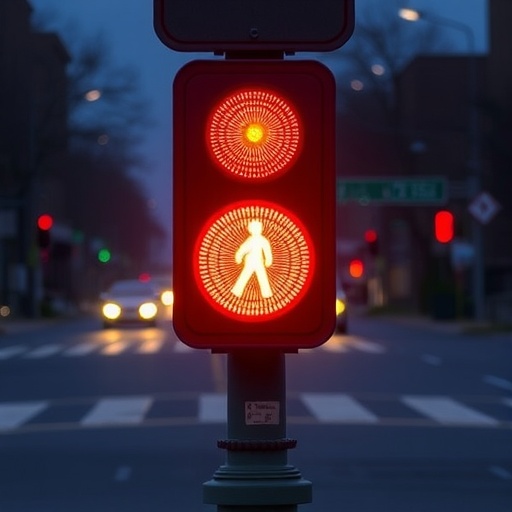In a striking revelation from researchers at the University of Massachusetts Amherst, a recent study uncovers a significant degree of confusion plaguing drivers interacting with pedestrian hybrid beacons (PHBs). Characterized by their unique five-phase signaling system, PHBs are a novel solution aimed at enhancing pedestrian safety at mid-block crosswalks. As urban planning increasingly incorporates innovative traffic management solutions, understanding driver behavior in relation to these beacons is essential. The study, recently published in the esteemed Transportation Research Record, offers critical insights into the effectiveness and comprehension of these devices among motorists in Massachusetts.
Pedestrian hybrid beacons, unlike traditional traffic lights, utilize a series of visual indicators to communicate with drivers. The system is designed to remain “dark” until a pedestrian activates it by pressing a button. Following the activation, a sequence begins with flashing yellow lights. This phase signals to drivers that they should decelerate in anticipation. As the sequence progresses, drivers are met with solid red lights, signaling an imperative stop, followed by a flashing red light that permits them to proceed only if the crosswalk is clear. This framework facilitates a smoother flow of vehicular traffic while significantly bolstering pedestrian visibility. However, the effectiveness of such a system hinges greatly on driver adherence to these signals.
The findings of this observational study are alarming. Across a sample of ten varied sites within Massachusetts, nearly a quarter of the drivers failed to comply with the solid red light phase, effectively entering the intersection unlawfully. The study revealed that an overwhelming 65% of drivers ignored the flashing red light, which indicates a stop-and-go behavior akin to that observed at typical stop signs. This alarming statistic points to a concerning trend: drivers are not only confused by the signals but also potentially jeopardizing the safety of pedestrians. The study’s lead author, Angelina Caggiano, emphasized that many of these infractions stem from drivers who stop in lengthy lines only to proceed without yielding once the flashing red appears, oblivious to any pedestrians that may be attempting to cross.
The presence of cyclists and other fast-moving individuals, particularly at shared-path crossings, makes these findings even more critical. With a substantial portion of drivers rolling through at inappropriate times, the risk of accidents increases for other pedestrians who rely on predictable driver behavior during crossings. Specific instances noted an additional complication—drivers stopping prematurely during light cycles when they are expected to proceed. The study found that 9% of drivers came to an unnecessary halt while the lights were dark, and an alarming 19% did so during the flashing yellow phase designed for gradual movement.
What emerges from the data is a broader issue of driver education regarding traffic signals. A significant portion of drivers seems to misinterpret the communications intended by PHP systems, leading to premature stops that confuse subsequent drivers. This behavior has a cascading effect that can lead to dangerous situations, where following vehicles are uncertain of the signals due to the inconsistent actions of vehicles in front of them. When one driver stops despite no imminent pedestrian traffic, it causes confusion, potentially leading to others disregarding their red lights, driven by a mistaken belief that the crosswalk is clear.
Additionally, the study examined the conditions under which drivers engage with the PHB system, revealing a limited variance based on roadway type. Notably, on four-lane roads, driver compliance with stopping requirements during red phases was markedly lower, with 29% running solid red lights and 69% ignoring flashing red signals. In contrast, at urban two-lane roads, compliance was significantly higher, with only 11% of drivers neglecting to stop for solid red. These variances underline the importance of road design and its impact on drivers’ understanding and compliance with traffic signals.
Researchers also discovered that drivers exhibited greater caution in areas characterized by a high presence of pedestrians, as seen at rail trail crossings. This context made drivers more judicious in their stopping behavior, leading to an observable increase in stopping during the dark and yellow phases. This phenomenon highlights an important factor—while drivers’ comprehension of PHB signals is crucial, pedestrian volumes directly affect their behavior, creating a relatively complicated dynamic at shared crossings.
Given the prevalence of pedestrian fatalities nationally, the importance of educating drivers on the effective use of PHBs cannot be overstated. Both Caggiano and co-author Michael Knodler advocate for the re-evaluation of the device’s placement, particularly at crossings frequented by cyclists and pedestrians. As behavioral patterns become more established over time, researchers express optimism that compliance rates will improve, mitigating risk and enhancing pedestrian safety in tandem.
As pedestrian hybrid beacons gain traction as a favored approach to route design, a deeper understanding of how drivers interpret and interact with these signals is essential. Amid an evolving transportation landscape, strategies to enhance driver awareness and education will likely democratize the safety of these systems. The urgency is evident: as this device continues to integrate into urban packages, it must be backed by public understanding and adherence.
In conclusion, the body of research surrounding pedestrian hybrid beacons not only serves to highlight the innovative engineering behind them but also underscores a critical need for comprehensive education around their functionalities. A prominent takeaway from the UMass Amherst study indicates that the future of pedestrian safety may hinge on how well these systems are understood—as drivers become more familiarized with the nuanced signaling, the anticipated positive outcomes revolving around pedestrian safety could finally be realized in practice.
Subject of Research: Driver behavior regarding pedestrian hybrid beacons
Article Title: Field Study of Driver Behavior by Interval at Pedestrian Hybrid Beacons
News Publication Date: Not specified.
Web References: https://journals.sagepub.com/doi/10.1177/036119812513518
References: Not specified.
Image Credits: Angelina Caggiano, UMass Amherst.
Keywords
Transportation, Automobile Traffic, Traffic Flow, Transportation Infrastructure
Tags: driver confusion pedestrian hybrid beaconseffectiveness of pedestrian hybrid beaconsfive-phase signaling systeminnovative traffic management solutionsMassachusetts traffic safety researchmid-block crosswalk safetypedestrian safety traffic managementTransportation Research Record findingsUMass Amherst research studyunderstanding driver behavior PHBsurban planning traffic solutionsvisual indicators for drivers





